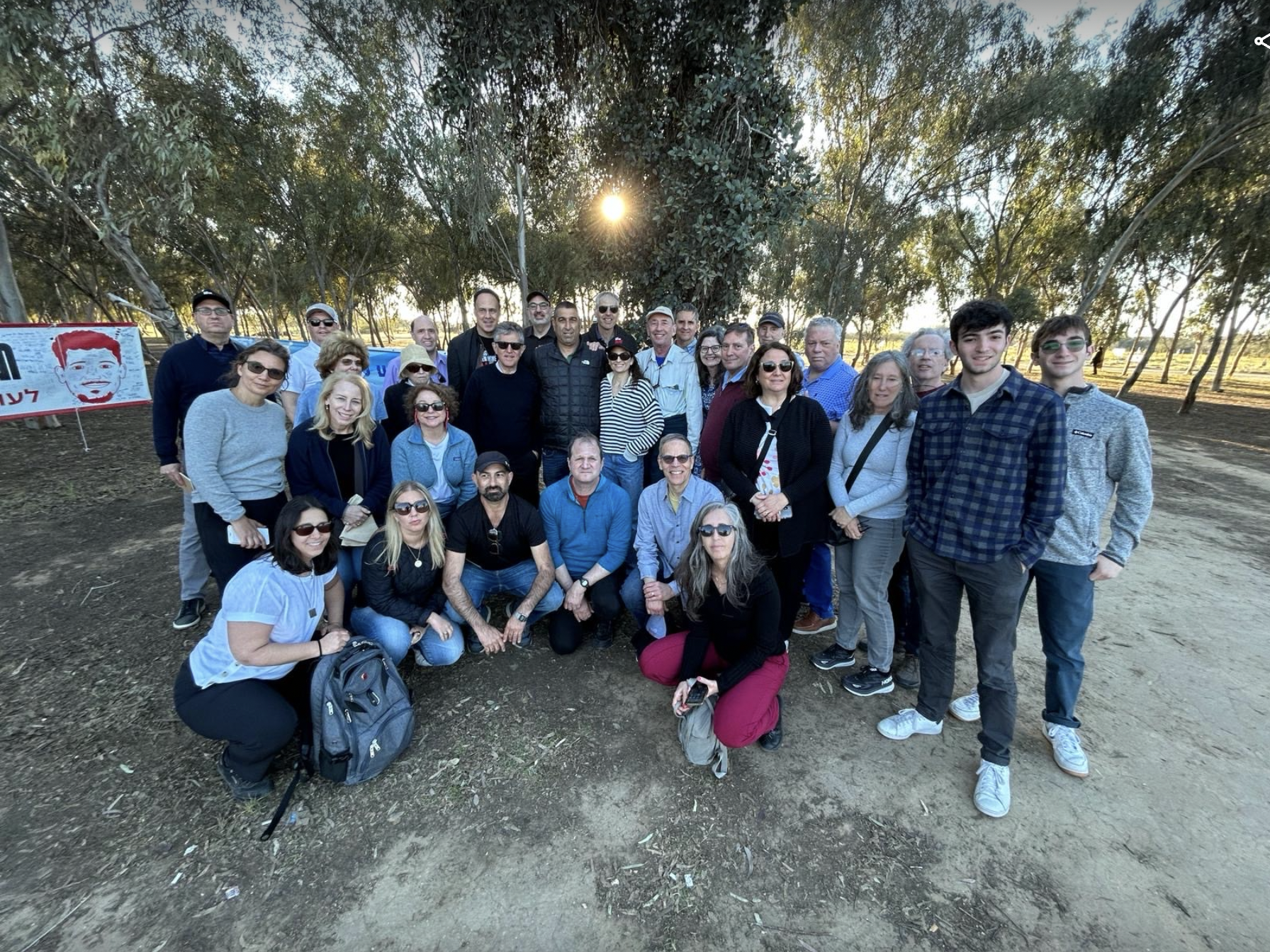Day 6- Wednesday, March 27: Sam Kopel
Day 6 offered our group a modest respite in that our activities were at least one degree of separation apart from the immediacy of the atrocities.
The day consisted of an 8:00am session with retired Major General Yair Golan after which we piled into the bus yet again heading to Jerusalem.
General Golan, a former MK of the Meretz Party, is tall and thin, with closely cropped gray hair and beard, projecting an unmistakable air of authority.
Like every other Israeli we encountered he thanked us for coming to Israel, which in his view is the best way to manifest support and unity. So if you're on the fence about going, Go...
On the morning of October 7th when the gravity of the situation finally dawned on him, he quickly donned his uniform, found his M16, drove to the southern district command headquarters, arriving by 10:30. He learned then of the utter chaos in the south. At the same time he received a phone call from his sister asking if he could arrange rescue of young people from the Nova Festival. Without a moment's hesitation he asked for their Google Maps coordinates. Being very familiar with the topography of the area he was able to find the kids by avoiding roads teeming with terrorists. Ultimately he did this three times, the last time arriving at the Nova site. He confirmed the scene of the devastation and horror that we had earlier this week heard from Rami.
He developed a feeling he had not previously known - a feeling of rage directed predominantly at the present government.
Leaving aside his personal story he turned to a discussion of the strategic issues.
1) Speaking as a military professional he marvelled at the brilliancy of the Hamas strategy and tactics. Knowing that Israel relied mainly on Sigint (electronic signals intelligence/wiretaps, intercepts, etc) Hamas leadership made sure to forego electronic communications feeding Israel misinformation intended for it to believe thatHamas had changed its colors - this went on for years, lulling us into a false sense of security. Israel believed it had properly understood Hamas' intentions.
2) They neutralized Israel's visual intelligence technology - a system of cameras deployed around the strip - by flying an off the shelf drone over the camera installations and dropping a grenade. They succeeded in blinding our ability to see the battlefield.
3) They knew all our (small) number of tank positions, and neutralized our only long range realiatory capacity.
4) They knew the locations and had elaborate maps of headquarter facilities, stormed them and killed all the (mainlyfemale) soldiers in the headquarters.
All together there were 70 Hamas penetrations of the security fence. The overall effect was that for many hours the IDF had tactical and strategic blindness. Yet despite this many individual IDF soldiers and civilians performed unbelievable heroic acts of bravery.
General Golan believes we brought this disaster on ourselves.
Hamas, founded in 1987, assuming control of Gaza in 2007, was dealt a heavy blow in 2008 by Operation Cast Lead. The then Prime Minister EhudOlmert had developed a strategy of strengthening the PA (by floating a possible return of the west bank) and weaken Hamas. Subsequent Bibi-led governments evolved a different approach: Spurred on by right-wing settlers whose Messianic desres included annexation of the West Bank, successive Bibi led coalitions evolved a strategy to weaken the PA (in control of the Arab parts of the West Bank) and by definition concentrate less on Hamas.
Ultimately the government came to believe that Israel had deterred Hamas; most Israelis believed it as well. According to General Golan, this is why we paid such a high price.
Switching gears, he turned to the schism in society in Israel in 2023, weakening our democracy which only encouraged our enemies. Issuing a warning that if we cannot maintain the current sense of unity, over one million Israelis will leave.
Whatever the outcome of the next election the new government will face five major challenges: security, equality, Haredi autonomy, democracy, diaspora relations. He believes the only way to bring down the current government is for Israelis to take to the streets again.
This- overly-long summary of the General's presentation should be balanced by acknowledging that he speaks from the perspective of the left wing of Israeli society. The Meretz party did not receive enough votes to participate in the current Knesset. But big wars often spark big changes.
On to Jerusalem and the Hartman Institute for a session with Rabbi Donniel Hartman. The institute is currently engaged in a new project "Israel of Tomorrow ''. Rabbi Hartman was asked by Rabbi Hirsh to discuss the morality of war.
Hartman speaks in a serene, gentle, avuncular manner, (yes, he wore a light sweater) in complete, soothing cadences, without resort to notes. To summarize a 45 minute talk: he told the group he has been studying morality of war for some time and is utterly convinced that if ever there was a just war, Israel is now engaged in one. It's a war of self defense, so by definition just. And yet, it is one thing to engage in a just war, another to fight a just war justly. Any war fought in an urban area will unavoidably involve the killing of civilians. This is particularly so if the enemy hides behind civilians, centers its war fighting capabilities among the civilian population using it as human shields. Gaza is a unique battle site in that combatants have turned civilian areas into a military facility utilizing hospitals, schools, mosques and the enormous system of tunnels; it is probably the single largest fortified facility in the history of warfare.
What differentiates morally just civilian casualties is the principle of proportionality: not a dry comparison of statistics, but an appreciation of the operational aims of any military operation: If a senior commander is in your gunsight, even in the midst of civilians, it is permissible, even just, to strike knowing that civilians will be killed. The same is not true for a strike at a militarily insignificant site. The IDF, perhaps uniquely, has a lawyer embedded with each battalion to help targeting decision making in real time. It does more to safeguard civilians than any army in the world.
Hartman stressed that it would ordinarily be the responsibility of the government (not the IDF's which is busy a the moment) to get the word out about how justly Israel is prosecuting this war. In the dissemination of information arena, the government has manifestly failed.
In the Q and A that followed, Malcolm (freshman at Brown University) asked for advice about responding to fellow students wearing kaffiyehs and accusing israel of all the shopworn calumnies of the day. Rabbi Hartman responded by urging Malcolm not to rely on argument based on facts - that side is impervious to factual arguments. Rather, focus on values: engage with fellow student by telling them about your first hand experience in Israel, the stories you can relate, and entrust that your reputation for integrity and trustworthiness will slowly make a dent. At the end of the day, the Jewish people evolved the moral code of the West; if you stick to your values, you (and our folk) will prevail. Adherence to our values for millenia helped make us the eternal people. Where are the Hittites??
A short stop at the souk for lunch and shopping (no one beats Rabbi Fersko at high speed shopping in the souk) was followed by a trip to the Israel Antiquities Authority, housed in a magnificent Moshe Safdie designed facility. We were met by Akira, a former colleague of the rabbis from the Stephen Wise Free Synagogue, but currnetly a manager at the IAA. It was this relationship that allowed our access to the facility that is not yet open to the public. A series of hugs ensued as colleagues met again after years of separation.
Akira told us the current focus of the archeological authority is to contiue to document the connection of the Jewish people with the land (as if that were needed in a sane world). As of October 7th, the scholars and staff of the IAA were instantly struggling to find ways to use their special knowledge and skills to help in any way theiy could.
One project - a technological marvel - we met with included a team of 3-D computer modeling experts tasked with documenting the magnitude of the pogrom. We were shown 3D images of sites of destruction in which the scientists used advanced tools to preserve the scenes of crimes for posterity. The images were mesmerizing in their ability to peer around blind corners and recreate houses, shelters and other sites in grim detail. The aims of the project are two fold: 1) to preserve and memorialize the images so as not to forget, and 2) to preserve evidence for future investigations and possible legal proceedings. The 3D images will ultimately be integrated with other imaging sources to create an incontrovertible chain of evidence.
Next, we met with Joe Uziel, chief of the Dead Sea Scrolls Collection unit. Joe described the architect community zeal to "do something" in the immeditate aftermath of Oct. 7th. He set up teams to sift though the wreckage as carefully as they would sift through an ancient site. On their hands and knees the architects searched for artifacts - but with the difference that they were searching for remains of people alive only days, not centuries or millennia ago. Whenever they found a piece of jewelry, a tooth or a fragment of bone, each piece would help identify a victim so that their families might ultimately reap the consolation of closure and mourn as appropriate. At this juncture the team has identified every missing person as either alive, dead or in captivity.
Finally, we were treated to a descent to the minus 8th story of the facility for a short session with the IAA's coin collection (of which there are more than 300 thousand). Any coin found in any shovel full of Israeli dirt is the property of the state.The group was shown coins dating as far back as the beginning of minting (6 centuries BCE), the first temple period, from the Bar Kochba revolt era and later Egyptian Muslim era. Fascinating to peer at these priceless artifacts under our very noses. The day ended with information about the many thousand of Dead Sea Scrolls fragment pieces still undeciphered in the laboratory. The IAA firmly believes its campus will one day become one of the world's greatest collection of archeological artifacts - the facility has several empty underground floors waiting to be placed into service.
And then back on the bus for our weary souls. Every way we turn and every place we go to offers confirmation of the "can do" spirit, the courage and genius of our brethren. An example fit for the ages.



